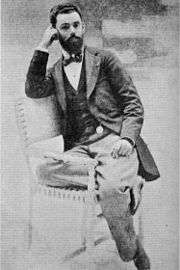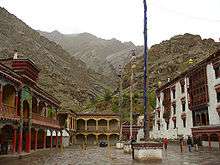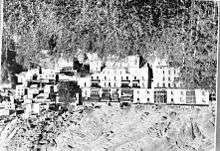Nicolas Notovitch

Shulim or Nikolai Aleksandrovich Notovich (Николай Александрович Нотович), known in the West as Nicolas Notovitch (1858-after 1916) was a Crimean[1] Jewish adventurer who claimed to be a Russian aristocrat[2][3] and journalist.
Notovitch is known for his 1894 book claiming that during his unknown years, Jesus left Galilee for India and studied with Buddhists and Hindus there before returning to Judea.[4][5][6] Notovitch's claim was based on a document he said he had seen at the Hemis Monastery while he stayed there, but he later confessed to having fabricated his evidence.[7][8]
Some modern scholars view Notovitch's accounts of the travels of Jesus to India as a hoax which includes major inconsistencies.[8][9][10][11]
Notovitch also wrote some political books on the role of Russia in war.[12][13]
Life of Saint Issa
Outline of the book
Notovitch claimed that he broke his leg in India and while recovering from it at the Hemis monastery in Ladakh, he learned of the "Life of Saint Issa, Best of the Sons of Men" – Isa being the Arabic name of Jesus in Islam. Notovitch's story, with the text of the "Life," was published in French in 1894 as La vie inconnue de Jesus Christ. It was translated into English,[5] German, Spanish, and Italian.

Notovitch claimed that the chief lama at Hemis told him of the existence of the work, which was read to him, through an interpreter, the somewhat detached verses of the Tibetan version of the "Life of Issa," which was said to have been translated from the Pali. Notovitch says that he himself afterward grouped the verses "in accordance with the requirements of the narrative." As published by Notovitch, the work consists of 244 short paragraphs, arranged in fourteen chapters. The otherwise undocumented name "Issa" resembles the Arabic name Isa (عيسى), used in the Koran to refer to Jesus and the Sanskrit "īśa", the Lord.
The "Life of Issa" begins with an account of Israel in Egypt, its deliverance by Moses, its neglect of religion, and its conquest by the Romans. Then follows an account of the Incarnation. At the age of thirteen the divine youth, rather than take a wife, leaves his home to wander with a caravan of merchants to India (Sindh), to study the laws of the great Buddhas. Issa is welcomed by the Jains, but leaves them to spend time among the Buddhists, and spends six years among them, learning Pali and mastering their religious texts. Issa spent six years studying and teaching at Jaganath, Rajagriha, and other holy cities. At twenty-nine, Issa returns to his own country and begins to preach. He visits Jerusalem, where Pilate is apprehensive about him. The Jewish leaders, however, are also apprehensive about his teachings yet he continues his work for three years. He is finally arrested and put to death for blasphemy, for claiming to be the son of God. His followers are persecuted, but his disciples carry his message to the world.
Allegations of forgery and claimed confession
Notovitch's book gained significant controversy as soon as it was published - historian Max Müller expressed incredulity at the accounts presented and suggested that either Notovitch was the victim of a practical joke, or had fabricated the evidence.[14][15] Müller said: "Taking it for granted that M. Notovitch is a gentleman and not a liar, we cannot help thinking that the Buddhist monks of Ladakh and Tibet must be wags, who enjoy mystifying inquisitive travelers, and that M. Notovitch fell far too easy a victim to their jokes."[7]

Müller then wrote to the head lama at Hemis monastery to ask about the document and Notovitch's story and the head lama replied that there had been no Western visitor at the monastery in the past fifteen years, during which he had been the lama there, and there were no documents related to Notovitch's story.[7][16] Other European scholars also opposed Notovitch's account and Indologist Leopold von Schroeder called Notovitch's story a "big fat lie".[7]
J. Archibald Douglas who was a professor of English and History at the Government College in Agra India then visited the Hemis monastery to interview the head lama who had corresponded with Müller and the lama again stated that Notovitch had never been there and no such documents existed.[16] Wilhelm Schneemelcher states that Notovich's accounts were soon exposed as fabrications, and that to date no one has even had a glimpse at the manuscripts Notovitch claims to have had.[8] Notovich at first responded to claims to defend himself.[17] But once his story had been re-examined by historians, Notovitch is said to have confessed to having fabricated the evidence.[7]
Bart D. Ehrman, a controversial Bible scholar and historian famous for his best sellers, says that "Today there is not a single recognized scholar on the planet who has any doubts about the matter. The entire story was invented by Notovitch, who earned a good deal of money and a substantial amount of notoriety for his hoax."[9]
However, others deny that Notovich ever accepted the accusations against him - that his account was a forgery, etc.
"Notovitch responded publicly by announcing his existence, along with the names of people he met on his travels in Kashmir and Ladakh. . . . He also offered to return to Tibet in company of recognized orientalists to verify the authenticity of the verses contained in his compilation. In the French journal La Paix, he affirmed his belief in the Orthodox Church, and advised his detractors to restrict themselves to the simple issue of the existence of the Buddhist scrolls at Hemis."[18]
Although he was not impressed with his story, Sir Francis Younghusband recalls his meeting with Nicolas Notovitch near Skardu, not long after Notovitch had left Hemis monastery.[19]
Corroboration in India
Although Notovitch had been discredited in Europe, Swami Abhedananda, a contemporary and colleague of Swami Vivekananda, visited the Hemis monastery in 1922 to confirm the reports of Notovich that he had heard the previous year in the USA. The lamas at the monastery confirmed to him that Notovich was indeed brought to the monastery with a broken leg and he was nursed there for a month and a half. They also told him that the manuscript on Jesus Christ was shown to Notovich and contents interpreted so that he could translate them into Russian.[20]
The original manuscript was said to be in Pali in the monastery of Marbour near Lhasa. The manuscript preserved at Hemis was in Tibetan. Swami Abhedananda himself was shown the manuscript, which had 14 chapters containing 223 couplets (slokas). The Swami got some portions of the manuscript translated with the help of a lama, about 40 verses appearing in the Swami's travelogue.[21]
The lamas told Swami that Jesus Christ came secretly to Kashmir after his resurrection and lived in a monastery surrounded by many disciples. The original manuscript in Pali was prepared "three or four years" after Christ's death, on the basis of reports by local Tibetans and the accounts from wandering merchants regarding his crucifixion.[22]
After his return to Bengal, the Swami asked his assistant Bhairab Chaitanya to prepare a manuscript of the travelogue based on the notes he had taken. The manuscript was published serially in Visvavani, a monthly publication of the Ramakrishna Vedanta Samiti, in 1927 and subsequently published in a book form in Bengali. The fifth edition of the book in English was published in 1987, which also contains as an Appendix, an English translation of Notovich's Life of Saint Issa translated from French.[23]
However, after Abhedananda's death, one of his disciples admitted that when he went to the monastery to ask about the documents he was told that they had disappeared.[24]
Other authors' references
Author Alice Dunbar-Nelson includes a review of The Unknown Life of Jesus Christ in her 1895 collection Violets and Other Tales.[25]
In 1899 Mirza Ghulam Ahmad wrote Jesus in India (published in 1908) and claimed that Jesus had traveled to India after surviving crucifixion, but specifically disagreed with Notovitch that Jesus had gone to India before crucifixion.[26][27]
Other authors have taken these themes and incorporated it into their own works. For example, in her book The Lost Years of Jesus: Documentary Evidence of Jesus' 17-Year Journey to the East, Elizabeth Clare Prophet asserts that Buddhist manuscripts provide evidence that Jesus traveled to India, Nepal, Ladakh and Tibet.[28] In his book Jesus Lived in India, German author Holger Kersten promoted the ideas of Nicolas Notovich and Mirza Ghulam Ahmad. Gerald O'Collins classified Kersten's work as the repackaging of the same stories.[29] In his 2002 comedic novel Lamb: The Gospel According to Biff, Christ's Childhood Pal, absurdist author Christopher Moore parodies the notion that between the ages of 15 and 30, Jesus traveled to Tibet to study Buddhism in a monastery (after first having traveled to Afghanistan), then to India to study Hinduism.
Other writings
In 1906 Notovitch published a book in Russian and French, pleading for Russia's entry into the Triple Entente with France and England. It is entitled in French: La Russie et l'alliance anglaise: étude historique et politique.[12] He also wrote biographies of Tsar Nicolas II and Alexander III.[30] He had also written L'Europe à la veille de la guerre[13]
References
- ↑ Born in Kertch on August 25th (13th Julian) 1858. Dictionnaire national des contemporains Vol. 3, Paris 1901, p. 274; Klatt, Norbert. 2011. Jesus in Indien: Nikolaus Alexandrovitch Notovitchs „Unbekanntes Leben Jesu“, sein Leben und seine Indienreise (2nd ed.). Göttingen: Norbert Klatt Verlag (Electronic resource; ISBN 978-3-928312-32-5; First print edition Stuttgart 1986)
- ↑ India Office Records: Mss Eur E243/23 (Cross)
- ↑ Public Record Office: FO 78/3998
- ↑ Notovitch, Nicolas. La Vie Inconnue de Jesus Christ. First Edition. Paris: Paul Ollendorff, 1894. (OCoLC 656630181; OCLC 20368915)
- 1 2 Virchand R. Gandhi (translator) (2003) [first published 1894]. The Unknown Life of Jesus Christ. Kessinger Publishing. ISBN 0766138984.
- ↑ Nicolas Notovitch (2006). The Unknown Life Of Jesus Christ: By The Discoverer Of The Manuscript. Translated by J. H. Connelly and L. Landsberg. Murine Press. ISBN 1434812839.
- 1 2 3 4 5 Douglas T. McGetchin, Indology, Indomania, and Orientalism, Fairleigh Dickinson Univ Press, 2009, ISBN 083864208X. Page 133: "Faced with this cross-examination, Notovich confessed to fabricating his evidence."
- 1 2 3 New Testament Apocrypha, Vol. 1: Gospels and Related Writings by Wilhelm Schneemelcher and R. Mcl. Wilson (Dec 1, 1990) ISBN 066422721X page 84 "a particular book by Nicolas Notovich (Di Lucke im Leben Jesus 1894) ... shortly after the publication of the book, the reports of travel experiences were already unmasked as lies. The fantasies about Jesus in India were also soon recognized as invention... down to today, nobody has had a glimpse of the manuscripts with the alleged narratives about Jesus"
- 1 2 Ehrman, Bart D. (February 2011). "8. Forgeries, Lies, Deceptions, and the Writings of the New Testament. Modern Forgeries, Lies, and Deceptions". Forged: Writing in the Name of God—Why the Bible’s Authors Are Not Who We Think They Are. (EPUB) (First Edition. EPub Edition. ed.). New York: HarperCollins e-books. pp. 282–283. ISBN 978-0-06-207863-6. Retrieved September 8, 2011.
- ↑ Stein, Gordon. (1993). Encyclopedia of Hoaxes. Gale Group. pp. 233-234. ISBN 0-8103-8414-0 "It appears that The Unknown Life of Jesus Christ is a hoax, probably perpetrated by Nicolas Notovitch himself. It continues to be printed in new editions and is still passed off as genuine."
- ↑ Price, Robert M. (2003). The Incredible Shrinking Son of Man: How Reliable is the Gospel Tradition?. Prometheus Books. p. 93. ISBN 978-1591021216 "It remains quite clear that Notovitch's Unknown Life of Jesus was a hoax."
- 1 2 La Russie et l'alliance anglaise: étude historique et politique by Nicolas Notovitch Paris, Plon-Nourrit, 1906.
- 1 2 L'Europe à la veille de la guerre by Nicolas Notovitch Paris A. Savine, 1890
- ↑ Simon J. Joseph, "Jesus in India?" Journal of the American Academy of Religion Volume 80, Issue 1 pp. 161-199 "Max Müller suggested that either the Hemis monks had deceived Notovitch or that Notovitch himself was the author of these passages"
- ↑ Friedrich M. Mueller, Last Essays, 1901. (republished in Jun 1973). ISBN 0404114393. Page 181: "it is pleasanter to believe that Buddhist monks can at times be wags, than that M. Notovitch is a rogue."
- 1 2 Bradley Malkovsky, "Some Recent Developments in Hindu Understandings of Jesus" in the Journal of Hindu-Christian Studies (2010) Vol. 23, Article 5.:"Müller then wrote to the chief lama st Hemis and received the reply that no Westerner had visited there in the past fifteen years nor was the monastery in possession of any documents having to do with the story Notovitch had made public in his famous book" ... "J. Archibald Douglas took it upon himself to make the journey to the Hemis monistry to conduct a personal interview with the same head monk with whom Meuller had corresponded. What Douglas learned there completely concurred with what Mueller had learned: Notovitch had never been there."
- ↑ D. L. Snellgrove and T. Skorupski, The Cultural Heritage of Ladakh, p. 127, Prajna Press, 1977. ISBN 0-87773-700-2
- ↑ Fida Hassnain. A Search for the Historical Jesus from Apocryphal, Buddhist, Islamic & Sanskrit Sources. Gateway Books, Bath, UK. 1994, p. 29.]]
- ↑ The Heart of a Continent, a Narrative of Travels in Manchuria, Across the Gobi Desert, Through the Himalayas, the Pamirs, and Hunza (1884-1894), 1904, pp. 180-181.
- ↑ Chaitanya 1987, p. 119.
- ↑ Chaitanya 1987, pp. 119-121, 164-166.
- ↑ Chaitanya 1987, p. 121.
- ↑ Chaitanya 1987.
- ↑ Hooper 2012, p. 176.
- ↑ Dunbar-Nelson, Alice (1895). Violets and Other Tales. Boston: Monthly Review. pp. 110–122.
- ↑ J. Gordon Melton, The Encyclopedia of Religious Phenomena, 2007. p377
- ↑ Mirza Ghulam Ahmad, Jesus in India, (Jul 1, 2003) ISBN 1853727237 pages iv-v (publisher's note)
- ↑ Prophet, Elizabeth Clare. The Lost Years of Jesus: Documentary Evidence of Jesus' 17-Year Journey to the East. p. 468. ISBN 0-916766-87-X.
- ↑ Gerald O'Collins and Daniel Kendall, Focus on Jesus, Mercer Univ Press 1998. ISBN 0852443609. pages 169-171
- ↑ Nicolas Notovitch, L'empereur Nicolas II et la politique russe, Paris : P. Ollendorff, 1895.
Bibliography
- Chaitanya, Brahmachari Bhairab (1987) [first published in Bengali in 1929]. Swami Abhedananda's Journey into Kashmir and Tibet. Rendered into English by Ansupati Daspupta and Kunja Bihari Kundi. Calcutta: Ramakrishna Vedanta Math. ISBN 0874816432.
- Hooper, Richard (2012). Jesus, Buddha, Krishna, and Lao Tzu. ISBN 1571746803.
Further reading
- Douglas, J. Archibald (1896). "The Chief Lama of Himis on the Alleged 'Unknown Life of Christ". Nineteenth Century. 39: 667–678.
- H. Louis Fader, The Issa Tale That Will Not Die: Nicholas Notovich and His Fraudulent Gospel (University Press of America, 2003). ISBN 978-0-7618-2657-6
- Müller, Max (1894). "The Alleged Sojourn of Christ in India". Nineteenth Century. 36: 515.
- Angelo Paratico, The Karma Killers New York, 2009. This is a novel based on Notovitch story, set in modern times with flashbacks to the time of Jesus and to World War II. Most of it is based in Hong Kong and Tibet. It was first printed in Italy under the title Gli Assassini del Karma, Rome 2003.
External links
- Works by Nicolas Notovitch at Project Gutenberg
- Works by or about Nicolas Notovitch at Internet Archive
- Works by Nicolas Notovitch at LibriVox (public domain audiobooks)

- La vie inconnue de Jesus Christ, Internet Archive
- The Unknown Life of Jesus Christ by Nicolas Notovitch, audio book, YouTube.
- Robert M. Price, Jesus in Tibet - A Modern Myth